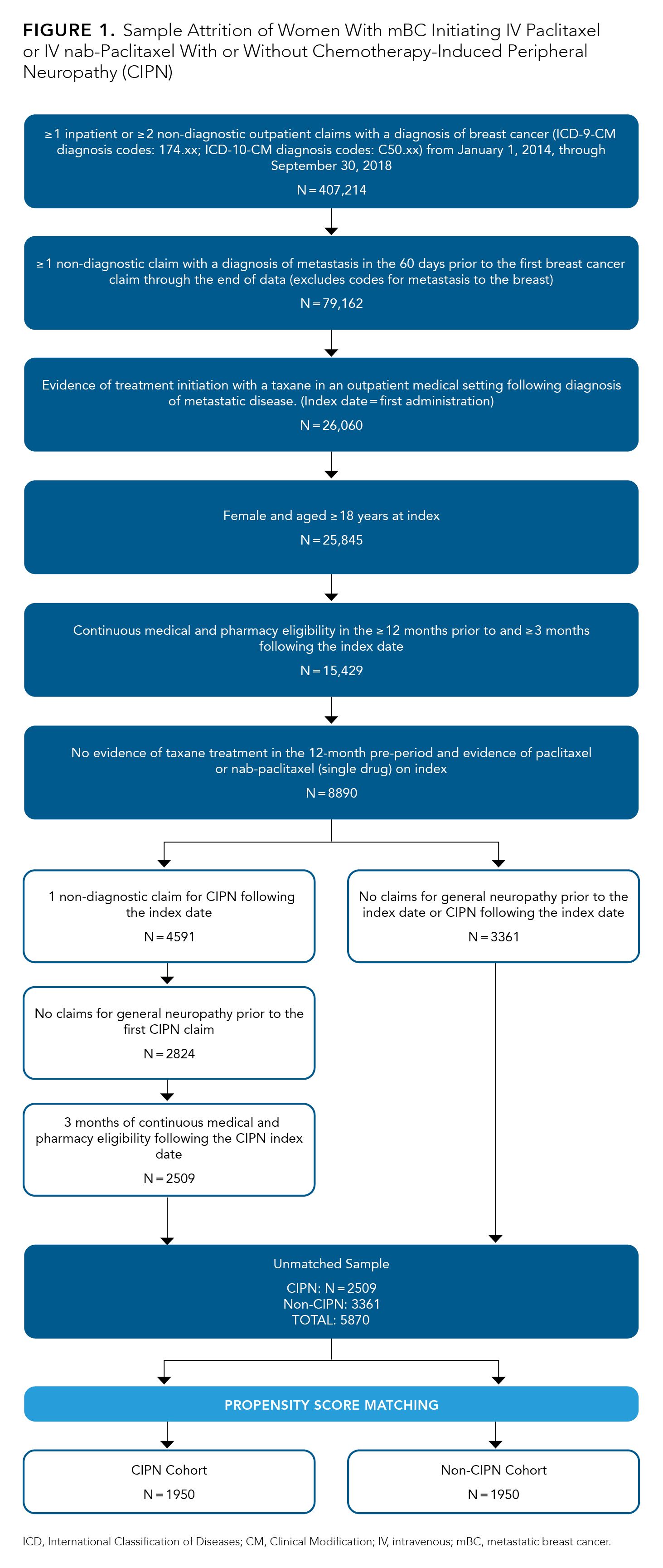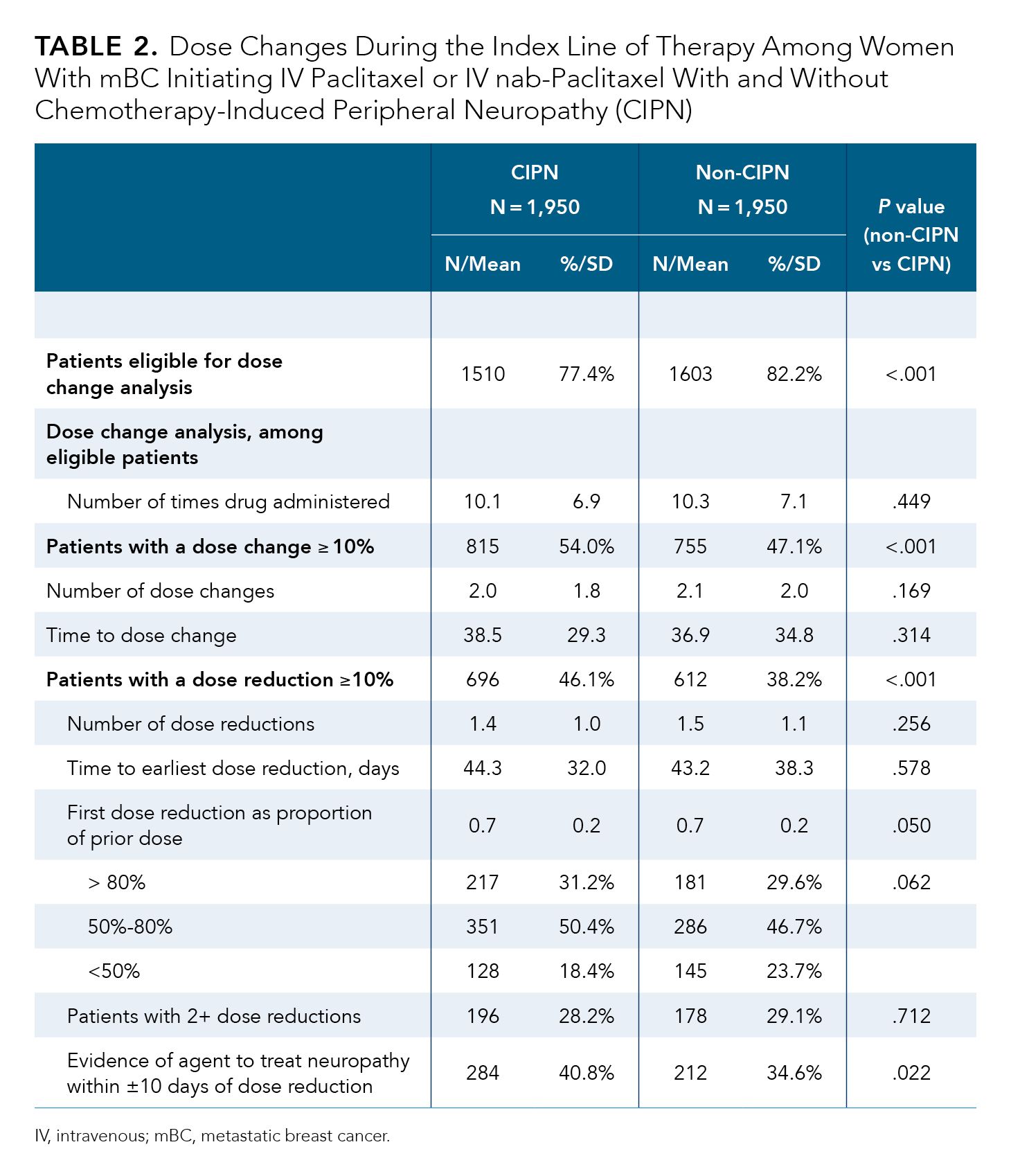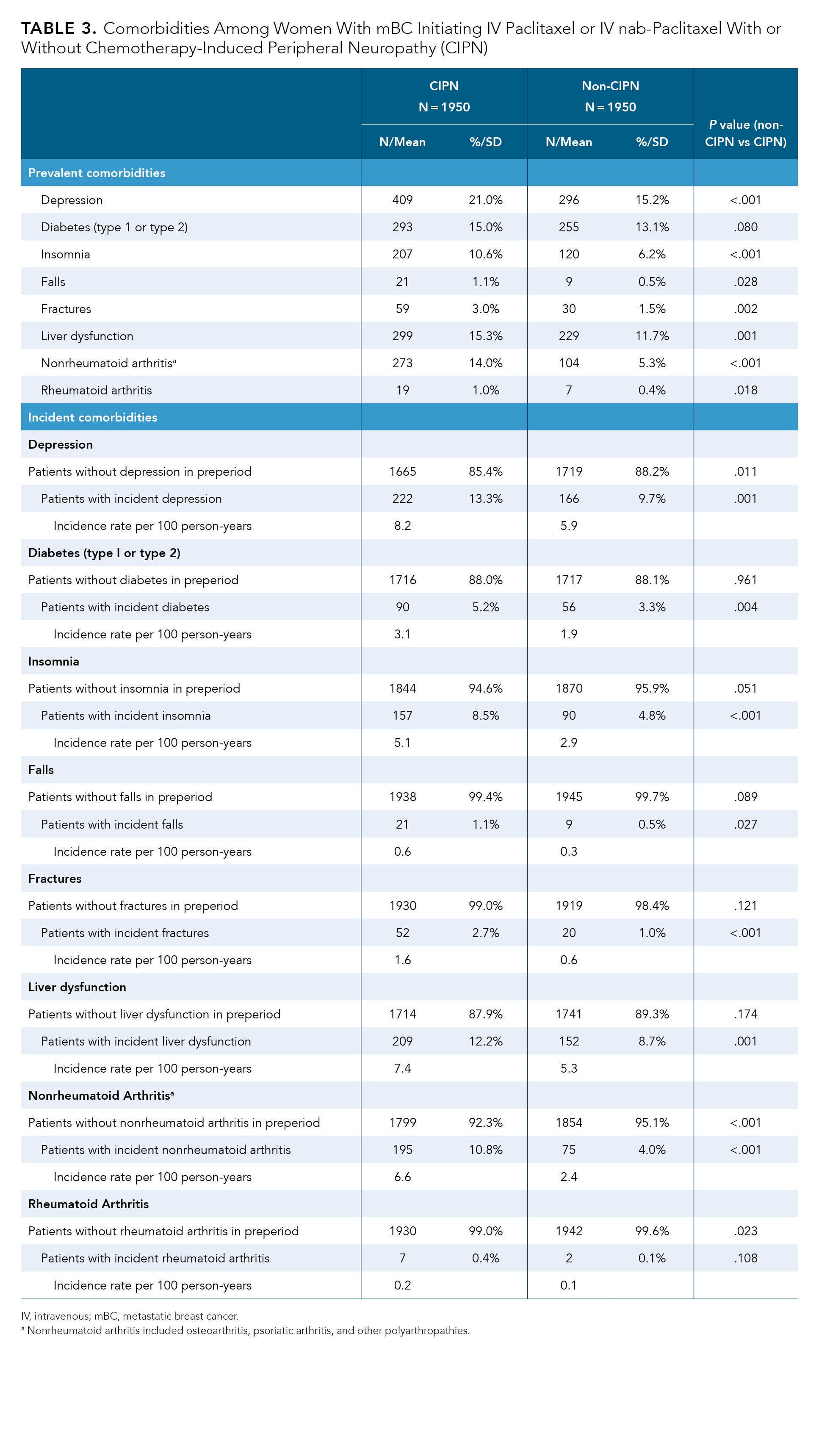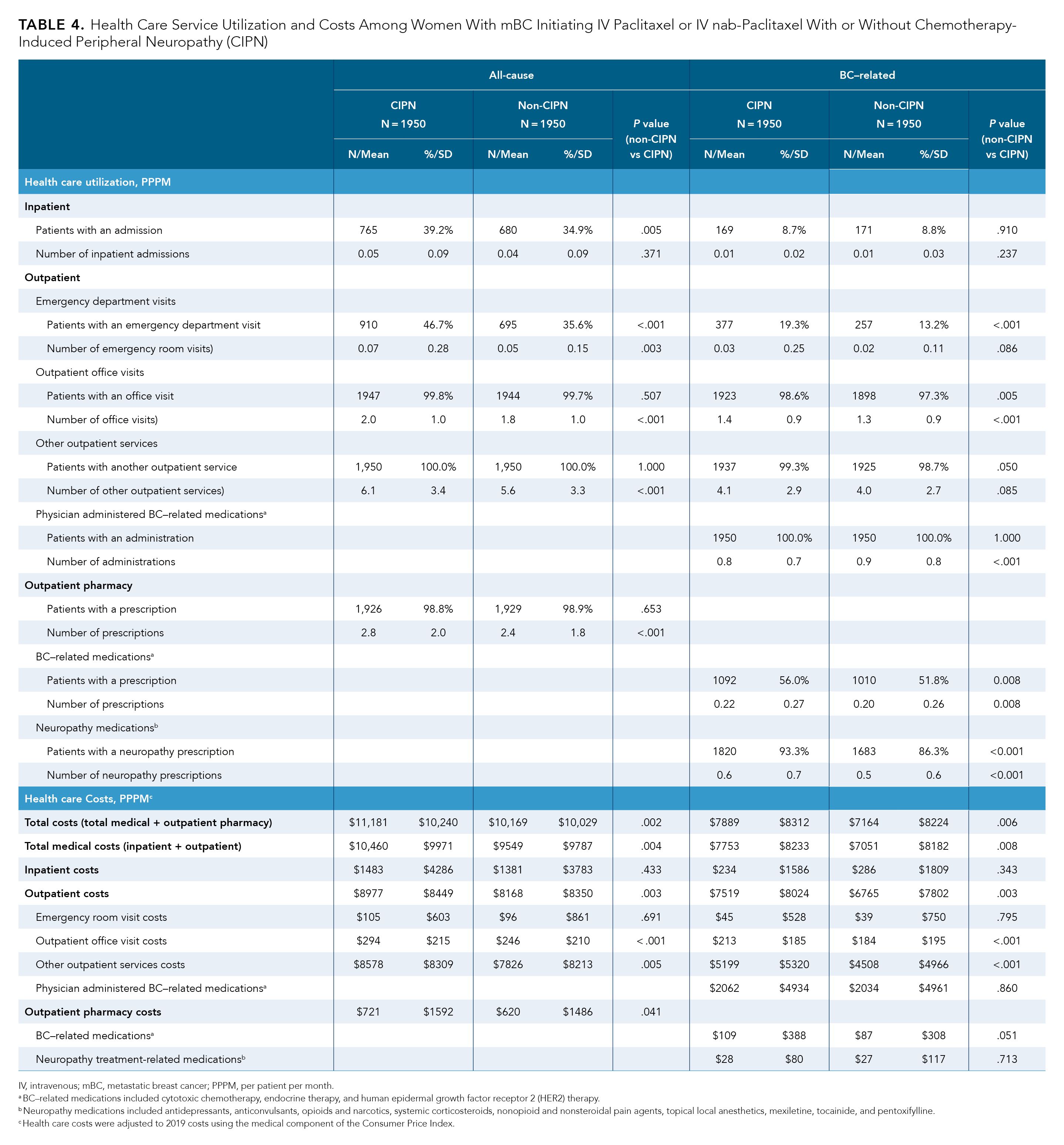Publication
Peer-Reviewed
Chemotherapy-Induced Peripheral Neuropathy in Metastatic Breast Cancer Patients Initiating Intravenous Paclitaxel/nab-Paclitaxel
Author(s):
We examine the incidence and impact of chemotherapy induced peripheral neuropathy on clinical and economic outcomes in women with metastatic breast cancer initiating intravenous paclitaxel/nab-paclitaxel.
ABSTRACT
Background: Intravenous (IV) taxanes for metastatic breast cancer (mBC) are associated with toxicities, such as chemotherapy-induced peripheral neuropathy (CIPN), which can detrimentally impact outcomes.
Objective: To assess the impact of CIPN on clinical and economic outcomes in women with mBC, initiating IV paclitaxel/ nab-paclitaxel.
Methods: Adult women in the MarketScan Commercial and Medicare Supplemental Database with a mBC diagnosis, initiating IV paclitaxel or IV nab-paclitaxel (index date = first administration) from November 1, 2013, to September 30, 2018, who had no prior neuropathy diagnoses, and continuous enrollment 12 months prior to and ≥ 3 months following index were selected. Propensity score–matched CIPN and non-CIPN cohorts were defined, based on postindex CIPN diagnosis. Clinical characteristics and all-cause and breast cancer (BC)-related health care utilization and costs per patient per month (PPPM) were compared between matched CIPN and non-CIPN cohorts during follow-up.
Results: Among the 5870 women with mBC initiating IV paclitaxel/nab-paclitaxel, 42.7% developed CIPN. The matched cohorts each included 1950 women. Patients with CIPN were more likely to have a dose reduction (46.1% vs 38.2%, P < .001) or develop depression, diabetes, insomnia, liver dysfunction, or arthritis compared with the non-CIPN cohort, P < .05. Patients with CIPN were more likely to have an inpatient admission (39.2% vs 34.9%, P < .01) or emergency department visit (46.7% vs 35.6%, P < .001), as well as all-cause and BC–related costs that were $1102 and $725 PPPM higher, respectively, than women without CIPN (P < .01).
Conclusions: CIPN was common in women, following IV paclitaxel/nab-paclitaxel treatment and was associated with dose reductions, the development of comorbidities, and elevated health care costs. Therapies for mBC that offer increased tolerability are needed to help improve patient outcomes and control costs.
Am J Manag Care. 2021;27(Spec 1). Published online December 23, 2020. https://doi.org/10.37765/ajmc.2021.88562
TAKEAWAY POINTS
Women with metastatic breast cancer (mBC) who develop chemotherapy-induced peripheral neuropathy (CIPN) after initiating intravenous (IV) paclitaxel or IV nab-paclitaxel, utilize more health care services and incur increased costs compared to women who do not develop CIPN. Patients with CIPN also experience an increased comorbidity burden and more treatment alterations in comparison to patients without CIPN. Treatments for mBC with reduced rates of CIPN are needed, to help improve long-term outcomes and reduce the burden on the health care system.
- 42.7% of women developed CIPN following initiation of IV paclitaxel/nab-paclitaxel
- Incremental all-cause and breast cancer-related health care costs were higher for patients who developed CIPN by $1102 and $725 per patient per month (PPPM), respectively.
INTRODUCTION
Despite advancements in therapy, metastatic breast cancer (mBC) remains incurable. Treatment is focused on palliative care, with goals of prolonging survival and improving quality of life (QOL).1 Intravenous (IV) taxanes are some of the most active chemotherapies for the treatment of mBC.2 However, taxanes are largely nonspecific and associated with treatment-related toxicities, the development of which can result in treatment alterations (eg, dose reductions and regimen changes) or delays.3,4
Chemotherapy-induced peripheral neuropathy (CIPN), which has been reported in >60% of patients with mBC treated with IV paclitaxel, is a common taxane toxicity.5,6 It is characterized by sensory and/or motor manifestations driven by peripheral nerve damage. The condition is believed to be caused by the loss of neuronal microtubule function, although solvents used in IV taxanes have also been implicated.4 The development of CIPN is dose-dependent and schedule-dependent; effects can also be cumulative and limit future treatment by requiring dose reductions, delays, or discontinuations.3,4 Furthermore, CIPN can become a chronic condition, leaving patients with long-term effects, including numbness, disability, and neuropathic pain.4,5,7,8
In addition to their impact on patient outcomes, treatment-related toxicities, like CIPN, can place an increased burden on the health care system. Studies have reported increased costs for patients with chemotherapy-related toxicities compared to those without.9-11 These costs can be substantial, with increases of up to 70% in monthly all-cause expenses when toxicities occur.9,12
Although studies have assessed treatment-related toxicities in mBC, few have been focused specifically on CIPN.9,10,12 Similarly, analyses of CIPN have not been focused specifically on mBC.5-8,11,13 This retrospective analysis examined the clinical and economic burden of CIPN in patients with mBC, initiating IV paclitaxel or IV nab-paclitaxel.
METHODS
Data Source
This retrospective cohort study utilized deidentified data from the US IBM MarketScan Commercial and Medicare Supplemental databases from November 1, 2012, to December 31, 2018. The commercial database contains the inpatient, outpatient, and outpatient pharmacy details of employees and their dependents, covered under a variety of health plans. The Medicare database contains the full health care details (medical and pharmacy) of retirees with Medicare supplemental insurance provided by employers, including both Medicare-covered and employer-paid portions.
Disability data were obtained from the MarketScan Health and Productivity Management Database from November 1, 2012, to December 31, 2017 (end of available data). This database contains short-term and long-term disability data for a subset of patients in the MarketScan Commercial and Medicare Supplemental Databases. All study data were obtained using codes from the International Classification of Diseases, Ninth and Tenth Revisions, Clinical Modification (ICD-9-CM and ICD-10-CM); Current Procedural Terminology Fourth Edition; Healthcare Common Procedure Coding System; and National Drug Codes.
Patient Selection and Study Period
Adult women with greater than 1 inpatient claim, or greater than or equal to 2 nondiagnostic outpatient claims for breast cancer (BC) (ICD-9-CM: 174. xx; ICD-10-CM: C50.xx) were identified within the MarketScan Commercial and Medicare Database from January 1, 2014 to September 30, 2018. Eligible women had greater than or equal to 1 nondiagnostic claim for metastasis occurring 60 days prior to the first BC claim, through the end of data (excluded codes for metastasis to the breast). The index date was that on which the first IV paclitaxel or nab-paclitaxel was administered (identified via the Healthcare Common Procedure Coding System [HCPCS]; hereafter referred to as IV paclitaxel/nab-paclitaxel). Continuous enrollment was required for 12 months prior to, and 3 or more months following the index date. Women who had undergone taxane treatment or had a neuropathy diagnosis (Supplemental Figure) in the preperiod were excluded, as were patients with greater than 1 taxane administration on the index date.
Patients with CIPN had 1 or more nondiagnostic claims with a diagnosis of neuropathy, paresthesia, myalgia, or arthralgia during follow-up, and were continuously enrolled for 3 or more months following the first neuropathy claim (to assess post-CIPN costs). Patients without CIPN had no neuropathy diagnoses during the study period. The final CIPN and non-CIPN cohorts were propensity score–matched based on preperiod characteristics, to control for demographic and clinical differences between groups. Covariates included evidence of any inpatient admission, length of follow-up, National Cancer Institute Charlson Comorbidity Index (NCI-CCI), use of neurotoxic agents, number of toxicities, number of chemotherapy agents administered, and evidence of endocrine therapy, radiation therapy, or BC–related surgery. A 1:1 match was implemented, with the nearest neighbor technique without replacement (see Supplemental Table).
The preperiod was the 12 months preceding the index date. Outcomes were assessed over the follow-up period, which extended from the study index date until the earliest of the following: (1) administration of docetaxel; (2) end of continuous enrollment; or (3) end of the study period (December 31, 2018). For patients with CIPN, follow-up included the duration both prior to, and following the diagnosis of CIPN.
Lines of Therapy and Dose Changes
The index line of therapy (LOT) included chemotherapies administered in the 37 days following index. Non-taxane chemotherapies included capecitabine, carboplatin, cisplatin, cyclophosphamide, doxorubicin, epirubicin, eribulin, fluorouracil, gemcitabine, ixabepilone, methotrexate, and vinorelbine. The 37-day period allowed the inclusion of concomitant medications administered on a different cycle. The end of the Index LOT was defined by a change in the regimen (switch, augmentation, or drop) or the end of follow-up. Discontinuation of a regimen component was defined as a treatment gap of 45 days or more.
The IV paclitaxel/nab-paclitaxel dose changes were assessed during the Index LOT. Dose was estimated by dividing the paid amount on IV paclitaxel/nab-paclitaxel claims by the wholesale acquisition cost. Capitated claims, claims with a JW modifier, indicating medication waste, or a $0 paid amount were excluded. To assess dose changes over time, only patients with 3 or more non-$0 claims for IV paclitaxel/nab-paclitaxel were included. The magnitude of a dose change was defined as greater than or equal to 10% of the index dose. Changes were examined in relation to the prior dose.
Patient Characteristics and Comorbidities
Demographics were measured on the index date. During the preperiod, the NCI-CCI was calculated.14,15 Prevalent comorbid conditions were assessed during the preperiod and follow-up. During follow-up, incident comorbidities were examined among patients who did not experience the specific comorbidity during the preperiod.
Health Care Resource Utilization and Costs
All-cause and BC–related health care resource utilization and costs per patient per month (PPPM), including inpatient admissions, outpatient medical encounters (emergency department [ED] visits, outpatient office visits, and other outpatient services), and outpatient prescriptions were reported during follow-up. The BC–related health care resource utilization and costs were defined using inpatient admissions with a primary diagnosis of BC; outpatient services with a diagnosis of BC in any position; medical or pharmacy claims for BC treatments (chemotherapy, endocrine therapy, human epidermal growth factor receptor 2 [HER2] therapy, or radiation); and pharmacy claims for neuropathy medications (antidepressants, anticonvulsants, opioids and narcotics, systemic corticosteroids, nonopioid and nonsteroidal pain relief, topical local anesthetics, mexiletine, tocainide, and pentoxifylline). Costs were calculated using paid amounts on adjudicated claims. Costs for capitated plans were estimated via payment proxy. Costs were inflated to 2019 US$ using the medical care component of the Consumer Price Index.16
Work Disability and Indirect Costs
The MarketScan Health and Productivity Management (HPM) Database was used to assess short-term and long-term disability and estimate indirect costs from November 1, 2012, to December 31, 2017. Because of the limited sample of patients with HPM data, the unmatched CIPN and non-CIPN cohorts were used for the work disability analysis. All eligible patients with available HPM data were included. The duration of the postindex period was based on the availability of HPM data that overlapped with the postindex period for the larger study. All outcomes were reported as PPPM. Indirect costs were estimated by applying an estimated daily wage to short-term or long-term disability days. Wages were calculated using sex and region-matched data from the US Bureau of Labor Statistics in 2017. Short-term and long-term disability was set as 70% and 60% of the wage rate per day, respectively.
Statistical Analysis
Continuous variables were reported as mean and standard deviation. Categorical variables were reported as frequencies and percentages. All data analyses were conducted using the WPS version 4.1 (World Programming, United Kingdom).
RESULTS
Of the 5870 women with mBC, initiating treatment with IV paclitaxel/nab-paclitaxel, 2509 (42.7%) were diagnosed with CIPN during follow-up. The mean time from index to CIPN diagnosis was 198.9 (± 231.5) days. After matching, the CIPN and non-CIPN cohorts each comprised 1950 women, and the cohorts were well matched (Figure 1, Table 1). The average follow-up was similar at 21.0 (± 12.1) months in the CIPN cohort, and 20.6 (± 12.9) months in the non-CIPN cohort. The time to first CIPN diagnosis was 169.4 (± 194.1) days, and 46.7% of the participants were diagnosed with CIPN during the Index LOT.
FIGURE 1.

TABLE 1.

Treatment Patterns
Most patients initiated IV paclitaxel (Table 1). Only 8.7% of the CIPN cohort and 11.9% of the non-CIPN cohort initiated IV nab-paclitaxel. The majority of patients with CIPN (82.9%) and those without CIPN (84.3%) received IV paclitaxel/nab-paclitaxel monotherapy. The duration of the Index LOT was also similar between cohorts at 96 (± 64) days in the CIPN cohort and 99 (± 63) days in the non-CIPN cohort. Patients with CIPN were more likely to end the Index LOT by dropping a medication (84.4% vs 81.2%, P = .010), whereas patients without CIPN were more likely to end the Index LOT because follow-up had come to an end (5.7% vs 2.3%, P < .001).
IV Paclitaxel/nab-Paclitaxel Dose Changes
Over 75% of the study participants qualified for the dose change analysis (CIPN, 77.4%; non-CIPN, 82.2%). Patients with CIPN were significantly more likely to undergo a dose reduction ≥ 10% during the Index LOT (46.1% vs 38.2%, P < .001, Table 2).
TABLE 2.

Among patients with a dose reduction, no significant differences were observed in the total number of, time to, or magnitude of dose reductions between cohorts (Table 2). However, patients with CIPN were more likely to receive a medication for neuropathy in +/- 10 days of a dose reduction, compared to patients without CIPN (40.8% vs 34.6%, P < .05).
Comorbidities
Preperiod comorbidity burdens were similar between cohorts (Table 1). During follow-up, patients with CIPN had a significantly higher prevalence of depression, liver dysfunction, nonrheumatoid arthritis, insomnia, rheumatoid arthritis, falls, and fractures, compared to patients without CIPN (P < .05, Table 3). The CIPN cohort also had a significantly higher proportion of patients with incident depression, diabetes, insomnia, falls, fractures, liver dysfunction, and nonrheumatoid arthritis (P < .05, Table 3).
TABLE 3.

All-Cause Health Care Utilization and Costs
Patients with CIPN had higher health care service utilization and direct all-cause costs PPPM over the follow-up. They were also more likely to have 1 or more inpatient admissions (39.2% vs 34.9%, P < .01) or ED visit (46.7% vs 35.6%, P < .001) compared to patients without CIPN (Table 4). Patients with CIPN also showed a significantly greater number of monthly ED visits, office visits, other outpatient services, and outpatient pharmacy refills over follow-up (Table 4).
Greater utilization of health care services translated to increased all-cause health care costs PPP for patients with CIPN compared to patients without CIPN. During follow-up, patients with CIPN incurred total all-cause health care costs that were $1012 PPPM higher, compared to patients without CIPN ($11,181 ± $10,240 vs $10,169 ± 10,029, P < .01). The higher costs for patients with CIPN were derived from a significantly higher number of office visits, outpatient services, and outpatient pharmacy costs (Table 4).
BC–Related Health Care Utilization and Costs
The CIPN cohort had significantly higher utilization of BC–related services and health care costs PPPM over follow-up. A significantly higher proportion of the CIPN cohort had 1 or more BC–related ED visits (19.3% vs 13.2%, P < .001); office visits (98.6% vs 97.3%, P < .01); or outpatient pharmacy refills for either a BC (56.0% vs 51.8%, P < .01) or neuropathy medication (93.3% vs 86.3%, P < .001) compared to the non-CIPN cohort. Patients with CIPN also had a significantly higher number of monthly office visits and outpatient pharmacy refills for BC or neuropathy medications (P < .01) (Table 4).
TABLE 4.

Higher utilization of BC–related outpatient medical and pharmacy services by the CIPN cohort led to an incremental cost for BC–related services of $725 PPPM, compared to the non-CIPN cohort. Increases in office and other outpatient services costs were the primary drivers of elevated costs (Table 4).
Work Disability and Indirect Costs
A total of 274 patients with CIPN and 314 patients without CIPN qualified for the short-term disability analysis. A greater proportion of patients with CIPN had a short-term disability claim during follow-up (58.0% vs. 42.0%, P < .001). No significant differences in lost workdays (CIPN, 5.1 ± 16.2; non-CIPN, 3.9 ± 11.0, P = .28); or indirect costs (CIPN: $702 ± $2185; non-CIPN: $539 ± $1657, P = .31) were observed between the cohorts. A total of 255 patients with CIPN and 288 patients without CIPN were included in the long-term disability analysis. No differences were observed between cohorts in the proportion of patients with a long-term disability claim (CIPN, 11.0%; non-CIPN, 12.0%, P = .567); the number of lost work days (CIPN, 1.3 ± 12.0; non-CIPN, 1.0 ± 3.8, P = .69); or indirect costs (CIPN, $169 ± $1586; non-CIPN, $122 ± $461, P = .63).
DISCUSSION
This claims-based study examined the burden of CIPN in patients with mBC, initiating IV paclitaxel/nab-paclitaxel. Among the 5870 women with mBC 42.7% developed CIPN over an average of 24.7 (± 13.7) months. The rate of CIPN identified in our study is higher than that of other claims-based studies, which report rates of peripheral neuropathy of less than 20%; there are several reasons for this difference.9,10,12 First, our analysis allowed patients to have prior, non-taxane chemotherapy, which may be associated with an increased risk of CIPN compared to studies limiting analyses to the first or second LOT.9,10,12 Second, our follow-up extended beyond the line of IV paclitaxel/nab-paclitaxel treatment, leading to a longer follow-up than studies that assessed toxicities during a LOT. Thus, the current findings provide new insight on the longer-term impact of CIPN in mBC.9,10
Fewer than half the patients with CIPN in our analysis were diagnosed with CIPN during the Index LOT. Therefore, the long-term burden of CIPN would have been underestimated if follow-up was limited to the Index LOT. Furthermore, other studies have reported that peripheral neuropathy is undercoded when assessed via ICD-9 codes.8 We used a broader CIPN definition, which included ICD-9/ICD-10 codes for peripheral neuropathy, paresthesia, myalgia, and arthralgia. These factors all likely resulted in higher overall rates of CIPN than previously reported in other claims-based analyses. However, the rate of CIPN identified in the current study is largely in line with, if not lower than, rates of CIPN reported in other retrospective, observational, or clinical trial analyses, which utilized electronic health records, patient surveys, or clinical scales to assess CIPN.6,8,17
Similar to other studies, the current analysis showed that CIPN in mBC is associated with increased health care service utilization and costs. All-cause costs for patients with CIPN were higher than those for patients without CIPN by $1102 PPPM, or approximately $13,224 per patient annually. The BC–related costs for patients with CIPN were higher than those for patients without CIPN by $725 PPPM, or approximately $8700 per patient annually. Hansen et al.10 used claims to examine costs in patients with mBC treated with taxanes, based on toxicity development. The monthly costs for patients with toxicities were $1142 higher during the first LOT, and $1448 during the second LOT than similar costs for patients without toxicities.
Hurvitz et al.9 found incremental costs for patients with mBC and toxicities that ranged from $845 to $5320 per month depending on the treatment and LOT. Similarly, Pike et al.11 reported incremental annual costs of $16,940, or approximately $1412 per month, in patients with BC who developed CIPN, compared to those who did not. The slightly lower incremental costs observed in our analysis likely resulted from two main methodological differences. The current study defined cohorts based on the presence of CIPN alone. Therefore, our non-CIPN group likely had a higher rate of non-CIPN toxicities compared to the cohorts without evidence of any toxicity in other studies.9,10 This difference would likely lead to a lower incremental cost. Secondly, our analyses followed patients beyond their first LOT, resulting in a longer follow-up than most other studies.
The work disability analysis revealed limited differences between cohorts. The population comprised patients with mBC, who may be less likely to return to work owing to advanced disease, a point which cannot be overlooked when assessing disability. Similarly, Pike et al.11 used employer disability data and found a nonsignificant trend for increased disability claims and disability days among patients with CIPN. Zanville et al.13 surveyed BC survivors regarding their ability to work; a greater proportion of patients reported being able to work at 1 year vs 1 month, leading the authors to conclude that patients developed coping mechanisms that facilitated a return to work with time.
An association between CIPN and QOL impairments has also been reported.5,7,8,17 Winters-Stone et al.7 used a patient survey and found that CIPN symptoms were significantly associated with worse functional performance, gait abnormalities, and an increased risk of falls. In the current analysis, no differences in the prevalence of fractures or falls were found between the CIPN and non-CIPN cohorts during the preperiod. Conversely, during follow-up, the CIPN cohort was significantly more likely to experience a fall or fracture compared with the non-CIPN cohort.
Bao et al.17 also reported an increased rate of falls with more severe CIPN. Two studies reported an increased use of pain medication among patients with neuropathy following chemotherapy.5,8 Similarly, the current analysis showed that patients with CIPN also had increased use of neuropathy medication, many of which were also pain medications. Furthermore, Bao et al.17 reported increased rates of patient-reported anxiety, depression, and insomnia with increased CIPN severity. The current analysis mirrored this finding with an increased prevalence and incidence of depression and insomnia in patients with CIPN vs patients without CIPN during follow-up.
Limitations
The study included patients with commercial or Medicare supplemental insurance. Thus, the results may not be generalizable to patients with other types of insurance or the uninsured. In addition, patients had 3 or more months of postindex enrollment, and patients with CIPN had 3 or more months of enrollment following a diagnosis of neuropathy. Thus, the results may not be applicable to patients who die shortly after the initiation of IV paclitaxel/nab-paclitaxel or a CIPN diagnosis.
Misclassification of clinical status, diagnoses, or other outcomes is possible, as administrative claims are collected for billing, and are subject to miscoding and undercoding. This may be particularly relevant when assessing CIPN as a previous study reported the undercoding of neuropathy.8 Furthermore, the lack of clinical data (eg, cancer stage, biomarkers, pain scales, etc.) makes it difficult to assess the severity of cancer or CIPN. Relative dose changes were estimated using paid amounts on claims. Changes in rebates, variability in generic agent prices, or site of administration could all affect these estimates. Conclusions in the work disability analyses were limited because of the low sample sizes. Not all patients could have been matched, as 22% of the CIPN cohort and 42% of the non-CIPN cohort were not matched 1:1.
CONCLUSION
CIPN is a common treatment-related toxicity in cancer. In this claims-based analysis, the long-term rate of CIPN in mBC was estimated at 42.7%. Development of CIPN following the administration of IV paclitaxel/nab-paclitaxel was associated with significantly higher utilization of all-cause and BC–related health care services and costs, an increased comorbidity burden, and more treatment alterations. These findings demonstrate the substantial long-term impact of chemotherapy and provide an estimate of both the patient burden and economic impact of CIPN. Considering the increasing survival of cancer populations with the availability of new treatments, the longer-term impact of toxicities, like CIPN, need to be considered throughout treatment. The development of alternative therapies with lower toxicity could provide substantial long-term benefits, not only for patients but also for the health care system.
AUTHOR AFFILIATIONS: IBM Watson Health, Cambridge, MA (BLB, ML, KW, HV, CLC); Mirador Global, Kennett Square, PA (KMF, CC); Athenex Inc., Buffalo, NY (JW, ID).
AUTHOR INFORMATION: Concept and design (BLB, KW, KMF, JW, CC, HV, ID); acquisition of data (BLB, KW, KMF, HV); analysis and interpretation of data (ML, KW, KMF, JW, CC, HV, CLC, ID); drafting of manuscript (BLB, ML); critical revision of manuscript for important intellectual content (KW, KMF, JW, CC, ID); statistical analysis (CLC); obtaining funding (JW, ID); administrative, technical, and logistical support (ML, KW, HV, CLC); and supervision (KMF, JW, CC, ID)
FUNDING SOURCE: This study was sponsored by Athenex, Inc.
CORRESPONDING AUTHOR: Brenna L. Brady, PhD; brenna.brady@ibm.com
AUTHOR DISCLOSURES: BLB, KW, and HV are employed by IBM Watson Health, which received funding from Athenex, Inc. to perform this study. ML and CLC were employed by IBM Watson Health at the time of this study. KMF and CC are employed by Mirador Global, which received research funding from Athenex, Inc. to conduct this study. JW and ID are employed by and own stock in Athenex. This research was presented in part at the 2020 Virtual Academy of Managed Care Pharmacy (AMCP) Nexus conference.
DATA AVAILABILITY STATEMENT
The data that support the findings of this study are available from IBM Watson Health. Restrictions apply to the availability of these data, which were used under license for this study.
REFERENCES
1. Cardoso F, Harbeck N, Fallowfield L, Kyriakides S, Senkus E. Locally recurrent or metastatic breast cancer: ESMO Clinical Practice Guidelines for diagnosis, treatment and follow-up. Ann Oncol. 2012;23(suppl7):vii11-19. doi: 10.1093/annonc/mds232
2. Ghersi D, Willson ML, Chan MM, Simes J, Donoghue E, Wilcken N. Taxane-containing regimens for metastatic breast cancer. Cochran Databse Syst Rev. 2015;2015(6):CD003366. doi: 10.1002/14651858.CD003366.pub3
3. Rashid N, Koh HA, Baca HC, et al. Clinical impact of chemotherapy-related adverse events in patients with metastatic breast cancer in an integrated health care system. J Manag Care Spec Pharm. 2015;21(10):863-871. doi: 10.18553/jmcp.2015.21.10.863
4. Rivera E, Cianfrocca M. Overview of neuropathy associated with taxanes for the treatment of metastatic breast cancer. Cancer Chemother Pharmacol. 2015;75(4):659-670. doi: 10.1007/s00280-014-2607-5
5. Reyes-Gibby CC, Morrow PK, Buzdar A, Shete S. Chemotherapy-induced peripheral neuropathy as a predictor of neuropathic pain in breast cancer patients previously treated with paclitaxel. J Pain. 2009;10(11):1146-1150. doi: 10.1016/j.jpain.2009.04.006
6. Seretny M, Currie GL, Sena ES, et al. Incidence, prevalence, and predictors of chemotherapy-induced peripheral neuropathy: a systematic review and meta-analysis. Pain. 2014;155(12):2461-2470. doi: 10.1016/j.pain.2014.09.020
7. Winters-Stone KM, Horak F, Jacobs PG, et al. Falls, functioning, and disability among women with persistent symptoms of chemotherapy-induced peripheral neuropathy. J Clin Oncol. 2017;35(23):2604-2612. doi: 10.1200/JCO.2016.71.3552
8. Shah A, Hoffman EM, Mauermann ML, et al. Incidence and disease burden of chemotherapy-induced peripheral neuropathy in a population- based cohort. J Neurol Neurosurg Psychiatry. 2018;89(6):636-641. doi: 10.1136/jnnp-2017-317215
9. Hurvitz S, Guerin A, Brammer M, et al. Investigation of adverse-event-related costs for patients with metastatic breast cancer in a real-world setting. Oncologist. 2014;19(9):901-908. doi: 10.1634/theoncologist.2014-0059
10. Hansen RN, Ramsey SD, Lalla D, et al. Identification and cost of adverse events in metastatic breast cancer in taxane and capecitabine based regimens. SpringerPlus. 2014;3:259. doi: 10.1186/2193-1801-3-259
11. Pike CT, Birnbaum HG, Muehlenbein CE, Pohl GM, Natale RB. Healthcare costs and workloss burden of patients with chemotherapy-associated peripheral neuropathy in breast, ovarian, head and neck, and non-small cell lung cancer. Chemother Res Pract. 2012;2012:913848.doi: 10.1155/2012/913848
12. Rashid N, Koh HA, Baca HC, Lin KJ, Malecha SE, Masaquel A. Economic burden related to chemotherapy-related adverse events in patients with metastatic breast cancer in an integrated health care system. Breast Cancer (Dove Med Press). 2016;8:173-181. doi:10.2147/BCTT.S105618
13. Zanville NR, Nudelman KN, Smith DJ, et al. Evaluating the impact of chemotherapy-induced peripheral neuropathy symptoms (CIPN-sx) on perceived ability to work in breast cancer survivors during the first year post-treatment. Support Care Cancer. 2016;24(11):4779-4789. doi:10.1007/s00520-016-3329-5
14. SEER-Medicare: Calcuation of comorbidity weights. Accessed December 11, 2020. https://healthcaredelivery.cancer.gov/seermedicare/considerations/calculation.html
15. Cho H, Mariotto AB, Mann BS, Klabunde CN, Feuer EJ. Assessing non-cancer-related health status of US cancer patients: other-cause survival and comorbidity prevalence. Am J Epidemiol. 2013;178(3):339- 349. doi: 10.1093/aje/kws580
16. Consumer Price Index details report tables Accessed March 1, 2020. https://www.bls.gov/cpi/home.htm
17. Bao T, Basal C, Seluzicki C, Li SQ, Seidman AD, Mao JJ. Long-term chemotherapy-induced peripheral neuropathy among breast cancer survivors: prevalence, risk factors, and fall risk. Breast Cancer Res Treat. 2016;159(2):327-333. doi: 10.1007/s10549-016-3939-0






